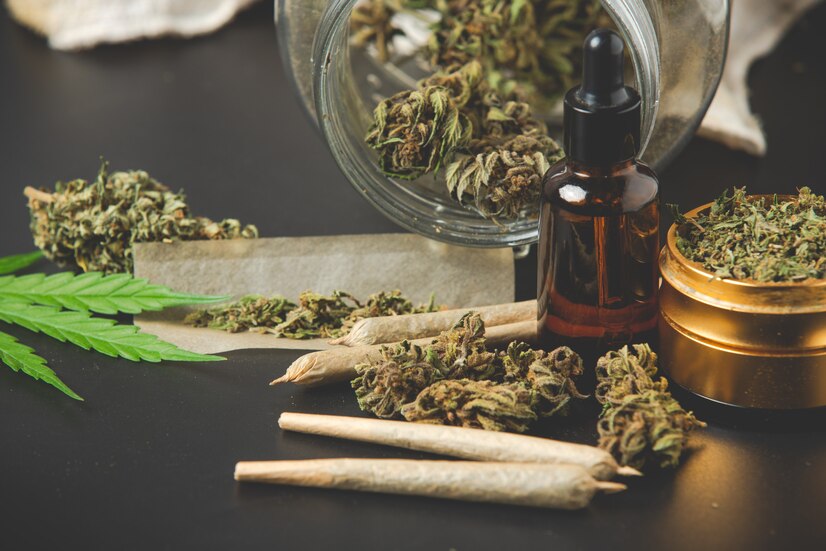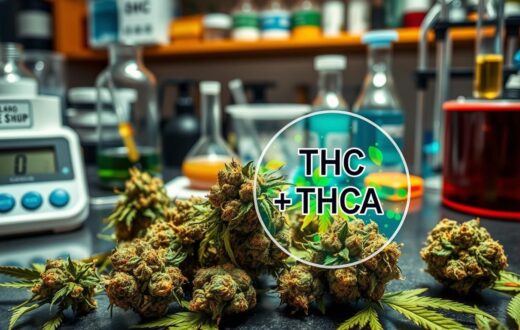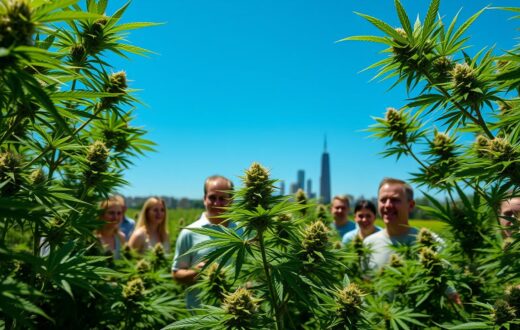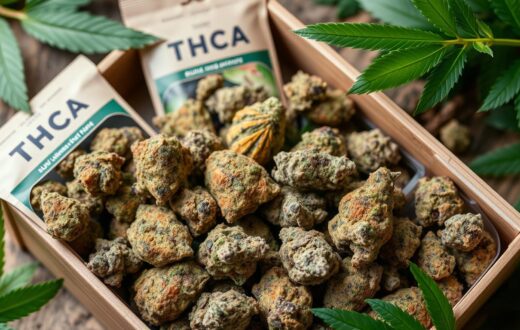Ever wondered why eating raw cannabis doesn’t produce the same effects as smoking it? The answer lies in a fascinating process called THCA decarboxylation. This chemical transformation is crucial in cannabis science, turning the non-intoxicating THCA into the psychoactive THC we’re more familiar with.
THCA decarboxylation isn’t just a fancy term – it’s the magic behind activating THC in cannabis. When you apply heat to your favorite strain, you’re kickstarting this process. It’s like turning a key in a lock, unleashing the full potential of the plant.
Let’s break it down: fresh cannabis flowers are packed with THCA, but it takes heat to transform it into THC. This conversion is what gives cannabis its psychoactive punch. The sweet spot? About 220°F (104°C) for 30-45 minutes if you’re doing it at home.
Why does this matter? Well, decarboxylation doesn’t just increase potency. It also boosts bioavailability, meaning your body can absorb and use more of the good stuff. For both recreational users and medical patients, understanding this process is key to getting the most out of cannabis.
Ready to dive deeper into the science of cannabis decarboxylation? Let’s explore how this simple chemical reaction shapes the world of cannabis as we know it.
What is THCA?
THCA, or tetrahydrocannabinolic acid, is a key compound found in raw cannabis plants. It’s non-psychoactive and is abundant in fresh cannabis flowers. It’s the precursor to THC but doesn’t cause the typical “high” from cannabis use.
Overview of Tetrahydrocannabinolic Acid
Tetrahydrocannabinolic acid is one of over 500 known cannabinoids in the cannabis plant. It’s mainly found in the plant’s smokable flowers. Fresh cannabis has more THCA than dried varieties. THCA is known for its potential therapeutic benefits, including anti-inflammatory and neuroprotective properties.
Differences Between THCA and THC
The main difference between THCA and THC is their effects on the human body. THCA doesn’t bind well to CB1 receptors in the brain, so it’s non-intoxicating. THC, on the other hand, interacts with these receptors, causing psychoactive effects. Raw cannabis compounds like THCA can be consumed through methods such as juicing, allowing individuals to experience potential cannabinoid benefits without intoxication.
The legal status of these compounds varies. While THC remains federally illegal in the U.S., THCA derived from hemp is legal under the 2018 Farm Bill if it contains less than 0.3% THC. This distinction has led to increased interest in THCA products, including THCA diamonds, among cannabis enthusiasts seeking alternative options.
The Process of Decarboxylation
Decarboxylation is a crucial step in cannabis chemistry. It turns THCA into THC, making the plant’s compounds active. Let’s dive into how it works and what influences it.
Chemical Reactions Involved
The decarboxylation process involves heating cannabis. This step removes a carboxyl group from THCA molecules. As a result, THCA transforms into THC. During this process, carbon dioxide and water vapor are released.
The magic happens at about 220°F (104°C). At this temperature, THC activation is most effective.
Factors Affecting Decarboxylation Rate
Several factors impact how fast and well decarboxylation works. Temperature is key. Too hot, and you might destroy the good stuff. Not hot enough, and you won’t get the full effect.
Time also matters. The longer you heat, the more THCA turns into THC. But be careful – overdo it, and you’ll lose potency. Moisture also plays a role. Dry cannabis decarboxylates differently than moist buds.
Interestingly, the decarboxylation process can affect how long your cannabis lasts. It speeds up THC breakdown, shortening its shelf life. On the flip side, non-decarboxylated THCA keeps its original taste and smell longer. It’s a trade-off between potency and preservation. Some folks prefer one over the other, based on their needs and likes.
Importance of THCA Decarboxylation
THCA decarboxylation is key to unlocking cannabis’s full potential. It affects both the potency and how well THC is absorbed by the body. This is important for both those who use cannabis for fun and those who use it for health reasons.
Effects on Potency and Bioavailability
Decarboxylation changes THCA into THC, the part of cannabis that gets you high. This makes cannabis more potent. It happens when the temperature is between 220°F and 245°F (104°C to 118°C).
If cannabis isn’t decarboxylated right, THC isn’t absorbed well. This means it doesn’t work as well when you eat it or drink it.
Implications for Medicinal Use
For people using cannabis for health reasons, decarboxylation is crucial. It makes THC and other good stuff work better. This is important for making sure edibles and oils work right.
Without decarboxylation, cannabis products might not work as well. This could mean they don’t help with symptoms as much.
Learning about decarboxylation helps users get the most out of cannabis. Whether making edibles or using other ways to take it, knowing how to use heat is important. It helps get the effects and health benefits you want.
Methods of Decarboxylation
Decarboxylation is key to unlocking cannabis’s psychoactive powers. The main method uses heat, usually around 240°F for 30-45 minutes. This turns THCA into THC, making the product stronger.
Heat Application Techniques
Oven decarboxylation is a favorite among home cooks. It involves baking cannabis at 230°F to 250°F for 20 minutes. Some prefer sous-vide for even heating. Companies use special ovens for top-notch quality.
Chemical Decarb Alternatives
Chemical methods are becoming more popular in the cannabis world. They use solvents or catalysts to convert THCA to THC. Companies use fluidized bed tech for big batches. Microwave decarboxylation is also growing, speeding up the process.
Storing decarbed cannabis right is crucial. Keep it at 70°F in airtight containers. Knowing these methods helps users choose how they want to enjoy their cannabis.
Decarboxylation in Cooking
Decarboxylation is a crucial step in making cannabis edibles. It makes the cannabinoids in weed active. This ensures your homemade edibles have the right effect. We’ll look at some common ways to cook with THC and important safety tips.
Popular Cooking Techniques
The oven method is a common way to decarboxylate cannabis. You heat 7 to 14 grams of ground flower at 250°F for about 30 minutes. Sous vide decarboxylation is another method. It uses warm water at 203°F for 90 minutes, ensuring the THC is activated without overcooking.
For those who like technology, the Levo Decarboxylation and Infuser machine is a good choice. It can process up to 7 grams of flour, decarbing in just 30 minutes. Although it costs $400, it’s perfect for those serious about making edibles.
Safety Considerations
When cooking with THC, safety is key. Start with small amounts of flower to get the hang of it. Store your decarbed cannabis in cool, dry places to keep it fresh. Remember, controlling the temperature is important. Too high, and you’ll lose the cannabinoids; too low, and they won’t work.
Mastering decarboxylation improves both the taste and strength of your edibles. This lets you control your cannabis cooking, making treats just the way you like them.
Benefits of THCA Consumption
THCA might offer health benefits without the high of THC. It’s found in raw cannabis and is getting attention for its special qualities. Let’s look at some key benefits of THCA that researchers have found.
Anti-inflammatory Properties
Studies show THCA could be anti-inflammatory cannabis. This might help those with arthritis or inflammatory bowel diseases. In animal studies, THCA showed it could reduce inflammation.
Neuroprotective Effects
Research indicates THCA is a neuroprotective cannabinoid. A study on mice showed THCA could protect against Alzheimer’s and improve memory. This suggests it might help with neurodegenerative diseases.
THCA’s ability to protect brain cells is an exciting area of research. Consuming THCA raw preserves its unique properties. More research is needed to confirm its therapeutic benefits.
THCA vs. THC: The Controversy
The cannabis world is buzzing with debate over THCA and THC. These two compounds spark discussions about thca legality and thc regulation. THCA, found in raw cannabis, doesn’t get you high. THC, its heated cousin, does. This difference shapes how we use and view cannabis.
Legal Status and Implications
THCA often faces less strict rules than THC. Why? It doesn’t cause a “high.” This gap in thc regulation creates a gray area. Some products high in THCA might slip through legal cracks. But be careful – THCA can turn into THC with heat. This shift could put you on the wrong side of the law.
Consumer Preferences
Cannabis consumer trends show a split. Some folks want THCA’s benefits without the buzz. Others seek THC’s effects. This divide drives product creation. Labels now highlight THCA content alongside THC. It’s a response to growing consumer knowledge. People want to know what’s in their cannabis and how it might affect them.
The THCA vs. THC debate shapes the cannabis market. It influences laws, products, and how we use cannabis. As research grows, so does our understanding. The future of cannabis might hinge on how we balance these two compounds.
The Science Behind Cannabinoids
Cannabinoid science has made great strides in recent years. We’ve learned that the cannabis plant contains over 100 unique compounds called cannabinoids. These interact with our body’s endocannabinoid system in fascinating ways.
Understanding Cannabinoid Interaction
When we consume cannabis, cannabinoids like THC and CBD enter our bloodstream. They then bind to receptors throughout our body and brain. This cannabis receptor interaction triggers various effects. It can influence mood, pain sensation, appetite, and more.
The Endocannabinoid System
The endocannabinoid system is a complex network in our bodies. It includes receptors, enzymes, and naturally-produced cannabinoids. This system helps regulate many vital functions. It plays a role in sleep, memory, mood, and appetite.
Understanding how cannabinoids interact with this system is key to developing new therapies. Research into the endocannabinoid system is ongoing. Scientists are exploring its potential to treat various health conditions. As we learn more, we may discover new ways cannabis can support wellness. The future of cannabinoid science looks bright.
Storage and Preservation of THCA
Keeping your cannabis in good shape is key to saving THCA and stopping THC from breaking down. Let’s look at some top tips to keep your cannabis quality high and its THCA content safe.
Best Practices for Maintaining Quality
To keep THCA safe, store your cannabis in sealed containers away from light. Glass jars with tight lids are great for this. Store it in a cool, dry spot to slow down the natural breakdown process.
For longer storage, think about refrigeration or freezing. But be careful not to let moisture build up when you take it out.
Impact of Light and Temperature
Light and heat are the big enemies of THCA. UV rays can damage cannabinoids, so use dark containers. Keeping the temperature right is also important.
High temperatures can quickly turn THCA into THC. Try to keep your storage spot between 60-70°F (15-21°C) to keep it potent.
Humidity matters too. Too much can cause mold, while too little can dry out your buds. Use humidity control packs to keep it between 59-63% relative humidity. By following these tips, you can keep THCA fresh and prevent THC from degrading, making your cannabis stay strong and fresh for longer.
Research on THCA Decarboxylation
Cannabis research has made big strides in understanding THCA decarboxylation. Recent studies have uncovered the complex ways THCA turns into THC. These discoveries are key for both medical and recreational cannabis use.
Recent Studies and Findings
A recent study looked at cannabinoid levels in secretory cavities and dried cannabis. It found that dried samples had more THC. For example, CBD levels were much higher in dried cannabis (4.79%) than in secretory cavities (1.16%). This shows how drying affects cannabinoid levels.
Clinical Trials and Outcomes
Decarboxylation clinical trials are looking into THCA and THC’s health benefits. One study compared acidic cannabinoid levels in different cannabis types. It found that dried cannabis had lower acidic cannabinoid ratios than secretory cavities. This info helps make better cannabis medicines.
THCA products are becoming more popular, leading to legal debates. The DEA stresses the need for post-decarboxylation testing for hemp. This shows the importance of ongoing research to guide laws and product creation in the cannabis world.
Consumer Awareness and Education
Cannabis education is key today. As THCa products grow in popularity, knowing how to read labels is vital. This helps in making smart choices and finding trustworthy sources.
Understanding Labels and Products
THCa flower has less than 0.3% delta-9 THC when it’s raw. This makes it legal under the US Farm Bill. It’s important to understand this when looking at labels.
Prices for THCa flower vary from $55 to $99. This offers good options for those watching their budget. Many sellers also include free humidity packs to keep the product fresh.
With over 1,392 reviews online, buyers can do their homework before making a purchase.
Knowing Your Sources
Finding reliable cannabis sources is crucial. Look for vendors that give detailed product descriptions and lab test results. Quality THCa flower is tested thoroughly to ensure it’s safe and potent.
Good sellers offer fast, discreet shipping and quick customer service. Remember, THCa becomes psychoactive when heated. So, it’s important to know its effects before using it. By focusing on education, consumers can make safe, legal choices in the changing cannabis market.
The Future of THCA Research
The world of cannabis science is changing fast. New research trends pop up every day. THCA is a compound with lots of potential.
Emerging Trends in Cannabis Science
Scientists are finding new ways to use THCA. They’re looking into its ability to fight inflammation and neurodegenerative diseases. The 2018 Farm Bill changed the rules, defining hemp as cannabis with less than 0.3% THC.
Potential New Applications
THCA’s uses are growing, and so is the field of cannabinoid science. Researchers are working on making products with just the right amount of THCA. This could lead to new medicines and treatments.
As the cannabis industry grows, so does the need for clear rules. States like California, Nebraska, and Florida are making laws about THC in hemp products. This shows how important it is to keep researching THCA to use its benefits safely.
Regulatory Considerations
Cannabis laws in the United States are complex and keep changing. The rules for THCA and THC differ from state to state. This makes it hard for producers and consumers in the cannabis industry.
Current Legal Landscape in the U.S.
The federal government says hemp is cannabis with less than 0.3% delta-9 THC. This includes THCA, which turns into THC when heated. The DEA’s view on this has caused a lot of debate.
It’s required to test for total THC before harvest. Products also need a certificate of analysis to show they meet the rules.
Future Legislation Impacts
Changes to the Farm Bill could change the hemp industry a lot. Some new rules might ban certain hemp-derived cannabinoids, like delta-8 THC. This worries people about the future of CBD products and other non-intoxicating hemp items.
Industry leaders want clear rules on intoxicating cannabinoid products. They want these rules to ensure safety and consistency.
The changing thc laws might affect the sale of THCA products. These products are legal because they don’t get you high before they’re heated. As laws evolve, the cannabis industry must keep up to stay legal and successful.
Conclusion: The Path Forward
Looking ahead, THCA and decarboxylation will be key in the cannabis industry. THCA hemp is becoming more accepted, changing the industry’s direction. But, there are challenges like regulation and keeping consumers safe.
Evolving Industry Dynamics
The cannabis world is changing fast, with THCA hemp flower becoming more popular. Hemp drinks are also growing, showing the industry’s wide range. But, THCA hemp is seen as risky, making legal and safety rules very important.
Advancements in Research and Technology
Research on THCA’s benefits is ongoing, focusing on its anti-inflammatory and neuroprotective effects. Law enforcement is using new methods like gas chromatography to test THCA hemp. These steps show the need for ongoing innovation in cannabis science.
Consumer and Business Considerations
For both users and businesses, knowing the difference between THCA and THC is essential. In places like Florida, where medical marijuana is legal, following rules is critical. As the industry grows, education and checking product authenticity will be vital for safe and legal use.















